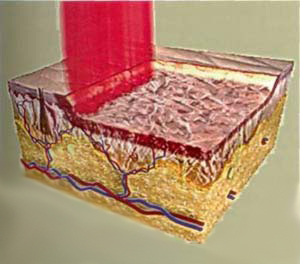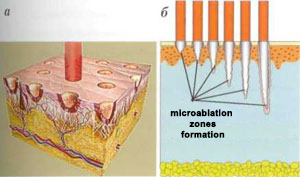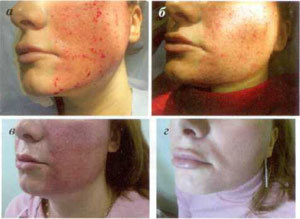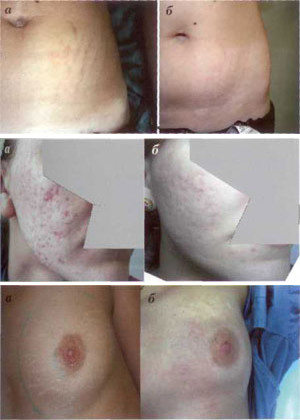Today the arsenal of modern dermatology has a fairly wide range of methods to correct various aesthetic skin imperfections - chemical peeling, mechanical dermabrasion, laser regeneration, microdermabrasion, contour plastics and others. Nevertheless, new directions and technologies are constantly evolving and improving in the beauty industry.
This trend is particularly specific to hardware methods, mainly for laser therapy. The use of lasers, first in dermatology, and then in cosmetology, is an influential period. Even among the newestThe presence of a laser treatment method - selective photothermolysis - has passed for more than 25 years. The pioneers of this direction, American RR Anderson and JA Parish, predetermined the fate of fractional lasers in medicine, allowing them to treat such beautySkin imperfections like capillary hemangioma. Port wine stains, hypertrichosis, tattoos, rosacea, pigmentation disorder, photographing, wrinkles etc.
modern skin remodeling technology
We live in a time when more people than ever are leading an aging life. And given that many of them continue active life, one of the most important problems in aesthetic medicine is aging skin. Fight against<
Plastic surgery is able to rejuvenate the shape of the face by removing excess skin. However, at the same time, the skin is still altered by time (age-related aging) or external factors (photoaging). It is also important that most patients want to look younger without surgery.
In this case, what method should be used to affect the skin and what should it contain for its actual rejuvenation?
All methods used to improve the appearance of the skin are united by one principle - they use traumatic effects on the skin, provoking fibrosis, which subsequently causes its stress and condensationIs made.
Currently, dermatology uses three main types of remodeling effects on the skin, including:
- Chemical stimulation - chemical peels with acids (trichloroacetic, glycolic, etc. );;
- Mechanical stimulation - mechanical dermabrasion, microdermabrasion, mesotherapy, filler, sub with needles < ;
- thermal excitation - laser ablation, laser and broadband light sources, radiofrequency lifting, thermolifting using partial methods. .
chemical stimulation
Historically, acid exfoliation (peeling) was the first method of skin rejuvenation. The principle of peeling is partial (with superficial peeling) or almost complete (with medium and deep peeling) destruction of the epidermis, damaging fibroblasts and dermis structures. This damage activates an inflammatory reaction (the more potent, the greater the amount of destruction), causing excess production of collagen in the skin.
However, to achieve the desired result, the peeling of the epidermis. Abandonment. Burning experiments have misled many, reportedly to "prove" that the epidermis is a self-renewal organ that quickly recovers on the damaged area. In this regard, the epidermis (For example, deep phenolic peeling) peeling became more aggressive some time ago, until accumulated problems made experts realize the malaise of this, a method that eventually thinned the skin.
Proponents of deep peeling ignored the emerging problems. Their essence was that due to the destruction of the papillas of the dermis and the weakening of nutrition, the epidermis became thinner, and the number of cells in the prickly layer was much lower thanWhat happened before peeling. Reduction in obstruction function of the stratum corneum leads to a decrease in hydration of the skin. (Therefore, almost all patients experience severe dryness of the skin after prolonged deep peeling). The light peels involved in the practice (using trichloroacetic and fruit acids) did not meet their expectations of effectively tightening the skin.
mechanical stimulation
Involuntary changes in the skin in methods of mechanical change, dermabrasion (with a speed of v, the rotation of the cutter up to 100, 000 rpm) with the use of rotary devices deserve special attention. Currently, modern Schumann-Schres devices. Used (Germany)
Themethod can only be used in a surgical hospital, as the procedure requires anesthetic assistance, postoperative treatment of the wound surface, a special toilet for the eyes and mouth, as well as equipment. Feeding patients. (Due to the fact that there are obvious postoperative swelling that occurs 2-3 days after the procedure, which makes it difficult to open the eyes and mouth).
Themethod is very effective, but, unfortunately, there is a high risk of complications with mechanical dermabrasion:
- persistent postoperative hyperactivity;
- When cutter penetrates through the basement membrane, the presence of areas of reduction due to the destruction of melanocytes; ;
- infection of the wound surface;
- scarring (if the cutter is too deeply submerged in the skin)
All of the above have determined the limited application of this method to clinical practice.
thermal stimulation
ablative remodeling
Since the late 1980s, a laser has been used to rejuvenate the skin by layer-by-layer tissue removal (ablation) [4]. Surface layer of skin using carbon dioxide laserCareful, less-painful removal, stimulates the synthesis of its own collagen in it. The amount of it increases manifold after the procedure. Then it is slowly reorganized.
The most effective was the use of a CO2 laser, when exposed to deep thermal effects on all layers of the dermis, externally manifested by the tightening effect of the skin. The method is called "laser dermabrasion", or "laserIt is called "revitalization", and in terms of efficiency it cannot be opposed by any other method of skin rejuvenation that existed at the time (Fig. 1).

Fig. 1. Traditional Laser Skin Revitalization (xerox)
The plan ofHowever, the CO2 laser also causes a large number of complications. In addition, further studies have shown that such a profound effect on the dermis contributes to the synthesis of new, normal fibrous tissue. Stimulates the formation of large amounts of concentrated collagen [5]. Developed fibrosis can make the skin appear unnaturally yellow. Collagen is synthesized after treatment, is reabsorbed after a few years, As a collagen is formed at the site of the scar. The epidermis, as a result of atrophy of the papillary layer of the thinningdermis, causes fine wrinkles to appear on the skin. Due to the weakening of barrier function of the stratum corneum, the level of skin hydration decreases. , And it looks atrophic.
Erbium-aluminum-yttrium garnet-erbium lasers appeared after some time. Such advantages as the shallow thermal penetration depth of erbium laser (erbium laser 30 μm, Penetrate to a depth of CO2 lasers - up to 150 μm) and (as a result) burn and tissue carbonizeThe relative cheapness (as compared to carbon dioxide lasers), along with the reduced risk of shank, attracted the attention of many experts around the world.
Yet, as experience with these two types of installations accumulates, opinions have developed among experts that CO2 lasers are more efficient [6]. The negative effects of carbon dioxide laser dermabrasion described aboveDespite this, this method remains indispensable for the correction of acne scars. In addition, it can be considered as an alternative to surgical skin tightening - in all methods of its remodeling, exposure to only CO2 lasers can actually be evident. Collagen contraction with visible clinical lifting effect.
The problem with all of the methods described above is that they often "sacrifice", that is, greatly damage the epidermis. To rejuvenate your skin and look really young, you need a naturalThe ideal epidermis requires papillis of the dermis, good hydration, normal skin tone and elasticity. The epidermis is a very complex highly specialized organ, up to 200 microns thick, our only defense against the effects of negative environmental factors. Therefore, the skinWhatever we need to do to rejuvenate, we need to ensure that its underlying common architecture is never damaged.
This concept contributed to the emergence of non-ablative skin remodeling technology.
non-ablative remodeling
The most common tools for non-ablative skin remodeling are neodymium (ND-YAG) and diode lasers as well as broadband light source (IPL). Their principle of action - selective photothermolysis - involves the heating and destruction of structures. , Containing substantial amounts of melanin or oxyhemoglobin. In the skin, these are accumulations of melanocytes (lentigo, melasma) and microvessels (telangiectasia), respectively. The emitted wavelengths used in non-impermeable lasers correspond to the maxima of the absorption spectra of oxyhemoglobin or melanin. The treatment process with non-impermeable laser and IPL is quite safe, the rehabilitation period is minimal, however, such treatment only eliminates pigment and vascular cosmic defects. In this case, a certain thickening of the skin. , But the effect achieved is short-lived.
partial skin remodeling technique
The continuous search for new highly effective and safe methods of skin rejuvenation at the same time has led to the emergence of a revolutionary technology - the partial delivery of laser radiation. The proposed skin rejuvenation method designed specifically to overcomeSome of the above difficulties have been encountered. In contrast to "traditional" ablative and non-ablative laser methods, which are designed to achieve uniform thermal damage to the skin at a specific depth, partial methods form several converted columns. To achieve its selective micro-thermal damage and leave unaffected areas around these microscopic lesions. Currently, the industry produces two types of fractional lasers: non-ablative and ablative.
first uses an aerobium-doped optical fiber that generates radiation at a wavelength of 1550 nm. Fractional laser forms in the skin in the form of thousands and tens of thousands of microadamage columns - Microthermal Treatment Zone (MLZ) - 70-Depth of mk with diameter of 150 1359 mcm
As a result, approximately 15–35 skin is photocoagulated on the treated area. The chromophore for the laser is water. Coagulation mainly occurs in the lower layers of the epidermis and dermis. The striatum corneum remains intact because it contains a relatively small amount of water, and it significantly reduces the risk of infection. Due to the reduced wound volume and the short migration distance of keratinocytes. The reason is rapid epidermal recovery. Moderate edema and hyperemia, with treatment duration, appear on the 5-7th day after decompression. The patient practically does not lose social activity.
This technique -Fractional Photothermolysis (FF) - a highly effective method of non-ablative fractional skin remodeling. To achieve the desired effect, a course treatment is prescribed. Depending on the clinical condition, it is recommended with an interval of 4–6 weeks. Perform 3 to 6 procedures. Like any other method of non-ablative skin remodeling, the end result can only be seen 4-8 months after the procedure (cumulative effect).

In cases where a more aggressive effect is required on the skin - for the improvement of scars, removal of deep wrinkles and excess skin, use the method of partial friction (FA, or partial deep dermal ablation -FDDA)Is done.
The partial friction method combines the benefits of a CO2 laser and the partial principle of laser radiation distribution. Unlike traditional CO2 lasers, which remove the entire skin surface layer by layer, FA units create a large number of microorganisms from 350 to 1800. area (MAL) up to 300 μm at the depth of evaporation of µm (Fig. 2).
.Thus, during this process, laser radiation penetrates into the deeper layers of the skin, destroying the upper layer of the epidermis. In terms of efficiency, ablative fractional laser rejuvenation can be compared with plastic surgery. Is, how deep is the laser beam resurfacing.
Fig. 2. Theory of operation of ablative fractional lasers: formation of microbiological zones - MAZ (A); Laser Radiation Power (b)
MAZ Formation Depth Dependence onAs with FF, 15 to 35% of the skin of the treated area is actually exposed (in some cases, up to 70%). FA process after layer-by-layer ablationRapid recovery after. This is important due to the fact that part of the epidermis and stratum corneum remains intact. The skin is bleeding for some time immediately after the procedure, but soon it stops (Image 3a, b).
Fig. 3. Step-by-step skin restoration after fractional ejaculation process: See (A) immediately after treatment; (B) every other day; (C) after 5 days; 14 days after a procedure (d)

Several microblades appear in the dermis, inducing a complex cascade of changes that occur to produce new collagen. After the bleeding stops, it is necessary to remove the remaining serous fluid on the skin surface. Is observed within 48 hours after the procedure, until complete epithelialization of the microbiological zone. During this period, the patient uses specialized wound healing external agents. Usually starts 3-4 days after peeling. And inflammation increases (Fig. 3C). By the 7th day, these events gradually decrease, and the erythema remains the only noticeable side effect (Fig. 3D). The duration of the erythema depends on the parameters of laser exposure. And features of skin vascularity. According to the author's observations, erythema does not last more than 3 months.
The patient's loss of social activity lasts 5 to 10 days after the FA procedure.
For the prevention of scarring and the manifestation of post-inflammatory pigmentation, careful care of the skin is necessary. Decorative cosmetics can be used from 4-5 days. A prerequisite for a good result is the use of high levels. Protection of sunscreen cosmetics for at least 3 months after the procedure (SPF at least 50). 20% of patients have a risk of post-inflammatory pigmentation and usually have a higher IV-V phototype in skin patients. Such hyperpigmentation is transient in nature and can last from 1 week to 3 months, which also depends on the depth of treatment and the area of area treated. For its prevention, 1-2 weeks before and during the procedure, 2 weeks after it, hydroquinone(4%) and external agents based on tretinoin (0. 1%) are prescribed. The main effects on facial skin after the FA procedure are as follows: clear tightness and excess skin loss, surface leveling of wrinkled skin, as well as acne. Skin affected by scars, lack of dyschromia, perforation.
This method was also tested by the author and colleagues to remove skin stretch marks. As shown by clinical studies, the method has shown high efficiency in the elimination of almost all types of stretch marks. Have demonstrated, both in puberty, achieved in the period and postpartum. It has been noted that the healing processes on body skin differ from those on facial skin.
Mechanism of skin remodeling when using partial lasers
Consider the mechanism of skin remodeling when using fractional lasers.
After exposure to the laser, aseptic inflammation develops in the area of microscopic lesions that form. The more aggressive the laser exposure, the more inflammatory the response, which, in fact, stimulates post-traumatic release. Growth factors and infiltration of tissues damaged by the fibroblast. The subsequent response spontaneously occurs with a burst of cellular activity, which inevitably leads to the fact that fibroblasts begin to produce more collagen and elastin. The remodeling process involves three classic stages of regeneration:
- Phase I - Transformation (tissue swelling). Starts immediately after injury;
- Phase II - Proliferation (tissue formation). Starts 3-5 days after injury and lasts for about 8 weeks;
- Phase III - tissue remodeling. Lasts from 8 weeks to 12 months.< / lix >
It should be noted that in all three stages skin remodeling is observed after partial photothermolysis and after partial friction. But in the first case, the damaging effect of the laser is moderately invasive, resulting in a waterfall change. Never goes wild.
A completely different picture is seen after exposure to a partial friction laser. The trauma caused by this laser causes blood vessels and blood cells to burst, as well as the serum into surrounding tissue. Whole-of-the-whole-skin mechanism of skin regeneration - Fe change begins - aseptic inflammation develops. Platelets released from damaged vessels play an important role in activating blood clotting and releasing chemoxic factors. In, other platelets, leukocytes, and fibroblasts are attracted. Leukocytes, especially in neutrophils, participate in the cleaning of the destroyed tissue, removing pieces of necrotic tissue that are partially phagocytized and partially destroyed. Epidermal and cutaneous tissue coming out on the skin surface in the form of micro debris containing substrate and melanin - microepidermal necrotic debris (meno).
Theproliferative phase begins in about 5 days. During this period, neutrophils are replaced by monocytes. Monocytes, keratinocytes, and fibroblasts continue to affect growth factors and at the same time under their reverse effectKeratinocytes stimulate the growth of the epidermis and the release of growth factors to stimulate the production of collagen by fibroblasts. In this stage, new blood vessels form, and the extracellular matrix is intensively formed.< / px >
The final, reconstruction, healing phase lasts several months after partial laser exposure.
By the 5th day after injury, the fibronectin matrix is "fitted" with which fibroblasts are lined and with which collagen will be formed. An important role in the formation of this matrix is the growth factor (TGF-β). ) Is played by converting chemotoxic agents to fibroblasts), as well as other growth factors. The predominant form of collagen in the early stage of perfusion is type III collagen (this type of collagen is located in the upper layer of the dermis, the basal layer of the epidermis. Below). The longer the transformation phase, the more type III collagen will be produced, but in any case, its volume increases to a maximum of 5 to 7 days after damage. Collagen type III is gradually reduced by collagen. Approximately one year is replaced with Type I, which strengthens the firmness of the skin. The blood circulation gradually returns to normal, the skin becomes smoother and acquires a natural color.
Comparative analysis of laser methods of skin remodeling
To summarize above, here is a diagram that shows the relationship between the effectiveness and safety of laser skin remodeling techniques.
Benefits of partial track rejuvenation methods. The benefits of fractional methods used in clinical practice include:
- controlled minimal skin damage. Histological studies performed after the procedure show an increase in the number of papules in the dermis, characterized by skin changes as productive regeneration;
- Its effective rejuvenation: The skin becomes thicker, it significantly (over 400% (! )) increases the production of collagen and elastin;
- Short therapy time: 3 days on average after FF and 7-14 days after PA;
- minimum risk of hyperpigmentation;
- possibility of performing the procedure in patients with thin skin;
- ability to exert healing effects on any part of the body;
- Possibility to use mild type of anesthesia: With fractional photothermolysis, only local application anesthesia is used, partial ablation requires a combination of conduction and infiltration anesthesia;
- disappearance of telangiectasis (due to the fact that blood vessels rupture at such places that their restoration is impossible. )
Key Indication for Partial Treatment

Indication for fractional photothermolysis:
- An increase in the density of skin
- in the early stages of aging. The FF procedure is relatively easy and can be administered without fear. Medical effects on the neck, dicolate, arms, abdomen, thighs, mammary glands. Can be inserted;
- skin photo;
- hyperpigmentation, mailsma;
- hypertrophic mark;
- stretch marks.
Indication for Partial Separation:
- wrinkles of varying severity - strongly accented by fine lines (as fur);
- age-related loss of skin elasticity and firmness;
- Extra skin in eyelids, neck, face (as an alternative to plastic surgery);
- uneven skin texture;
- Clear depiction of skin.
- acne scars; Injuries, skin after operation
- cicatricial deformity;
- Hyperpigmentation: Melasma, lentiginosis, macular pigmentation, etc.
- vascular dyschromia;
- skin stretch marks;
- actinic keratosis.
In conclusion, a few words about the possibilities of the use of laser technologies in aesthetic medicine. We should pay tribute to manufacturers that they began to pay more attention to the safety of medical procedures using lasers. Technology has steadily evolved. However, itsTo increase effectiveness, the safety of the method was often sacrificed. Or vice versa. A compromise was found in a new theory of delivering laser radiation to tissue. It should be noted that the type of parabolic sterilization remains: erbium, carbonDioxide, Neodymium. This shows that:
- First, laser skin remodeling is considered the most effective today;
- Secondly, the breadth of coverage of aesthetic and dermatological problems resolved by these methods is enormous - from skin rejuvenation to the treatment of congenital and acquired skin pathology;
- Third, with the advent of fractional technologies, the safety and effectiveness of treatment have become predictable.














































































